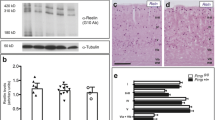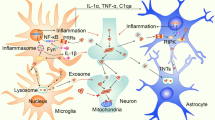Abstract
Transmissible Spongiform Encephalopathies (TSEs) are a group of neurodegenerative disorders affecting animals and humans and for which no effective treatment is available to date. Vacuolation, neuronal/neurite degeneration, deposition of pathological prion protein (PrPsc) and gliosis are changes typically found in brains from TSE affected individuals. However, the actual role of this last feature, microgliosis and astrocytosis, has not been precisely determined. The overall objective of this work is to assess the involvement of glial cells as components of the host protective system in prion propagation; specifically, to analyze the behavior of astroglial cells in prion progression. To achieve this aim, histopathological and immunohistochemical techniques were carried out on samples from cerebella using Scrapie as the prototype of natural TSEs as this made it possible to assess different stages of the disease; specifically, ages and genotypes from Scrapie-affected animals corresponding to different sources, by using optical, confocal and electron microscopy. The results provided in the present study demonstrate the indisputable involvement of astroglia in prion progression by showing specific changes of this glial population matching up to the evolution of the disease. Moreover, cerebellar lesions mainly associated to Purkinje cells that have not previously been reported in animal prion diseases in natural transmission are described here. The close relationship between PrPsc and GFAP hiperimmunoreactivity and Purkinje cells, alongside the evident thickening of their neurites at terminal stages demonstrated in this study, suggest that these neurons are the main target of this neurodegenerative disease.



Similar content being viewed by others
References
Abbott NJ, Rönnbäck L, Hansson E (2006) Astrocyte-endothelial interactions at the blood–brain barrier. Nat Rev Neurosci 7(1):41–53
Begley DJ, Brightman MW (2003) Structural and functional aspects of the blood–brain barrier. Prog Drug Res 61:40–78
Collins SJ, Lewis V, Brazier MW, Hill AF, Lawson VA, Klug GM, Masters CL (2005) Extended period of asymptomatic prion disease after low dose inoculation: assessment of detection methods and implications for infection control. Neurobiol Dis 20(2):336–346
DeArmond SJ, Qui Y, Sanchez H, Spilman PR, Ninchak-Casey A, Alonso D, Daggett V (1999) PrPc glycoform heterogeneity as a function of brain region: implications for selective targeting of neurons by prion strains. J Neuropathol Exp Neurol 58(9):1000–1009
Dehouck MP, Meresse S, Delorme P, Fruchart JC, Cecchelli R (1990) An easier, reproducible, and mass-production method to study the blood–brain barrier in vitro. J Neurochem 54:1798–1801
Furouka H, Horiuchi M, Yamakawa Y, Sata T (2011) Predominant involvement of the cerebellum in guinea pigs infected with Bovine Spongiform Encephalopathy (BSE). J Comp Pathol 144:269–276
Graeber MB (2010) Changing Face of Microglia. Science 330(6005):783–788
Graeber MB, Streit WJ (2010) Microglia: biology and pathology. Acta Neuropathol 119(1):89–105
Hawkins BT, Davis TP (2005) The blood-brain barrier/neurovascular unit in health and disease. Pharmacol Rev 57(2):173–185
Iadecola C (2004) Neurovascular regulation in the normal brain and in Alzheimer’s disease. Nat Rev Neurosci 5(5):347–360
Jeffrey M, McGovern G, Sisó S, González L (2011) Cellular and sub-cellular pathology of animal prion diseases: relationship between morphological changes, accumulation of abnormal prion protein and clinical disease. Acta Neuropathol 121(1):113–134
Martins VR, Liden R, Prado MA, Walz R, Sakamoto AC, Izquierdo I, Brentani RR (2002) Cellular prion protein: on the road for functions. FEBS Lett 512(1–3):25–28
Monleón E, Monzón M, Hortells P, Vargas A, Acín C, Badiola JJ (2004) Detection of PrPsc on lymphoid tissues from naturally affected Scrapie animals: comparison of three visualization systems. J Histochem Cytochem 52:145–151
Oswald MJ, Palmer DN, Kay GW, Shemilt SJ, Rezaie P, Cooper JD (2005) Glial activation spreads from specific cerebral foci and precedes neurodegeneration in presymptomatic ovine neuronal ceroid lipofuscinosis (CLN6). Neurobiol Dis 20:49–63
Press CM, Heggebø R, Espenes A (2004) Involvement of gut-associated lymphoid tissue of ruminants in the spread of transmissible spongiform encephalopathies. Adv Drug Deliv Rev 56(6):885–899
Prusiner SB, Bolton DC, Groth DF, Bowman KA, Cochran SP, McKinley MP (1982) Further purification and characterization of scrapie prions. Biochemistry 21(26):6942–6950
Rapoport M, van Reekum R, Mayberg H (2000) The role of the cerebellum in cognition and behavior: a selective review. J Neuropsychiatry Clin Neurosci 12(2):193–198
Rezaie P, Lantos PL (2001) Microglia and the pathogenesis of spongiform encephalopathies. Brain Res Brain Res Rev 35(1):55–72
Roucou X, Gains M, Le Blanc AC (2004) Neuroprotective functions of the Prion Protein. J Neurosci Res 75(2):153–161
Rubin LL, Staddon JM (1999) The cell biology of the blood-brain barrier. Annu Rev Neurosci 22:11–28
Sakaguchi S, Katamine S, Nishida N, Moriuchi R, Shigematsu K, Sugimoto T, Nakatani A, Kataoka Y, Houtani T, Shirabe S, Okada H, Hasegawa S, Miyamoto T, Noda T (1996) Loss of cerebellar Purkinje cells in aged mice homozygous for a disrupted PrP gene. Nature 380(6574):528–531
Sarasa R, Martínez A, Monleón E, Bolea R, Vargas A, Badiola JJ, Monzón M (2012) The Involvement of Astroglia in the Pathogenesis of Transmissible Spongiform Encephalopathies: A Confocal Microscopy Study. Cell Tissue Res 350(1):127–134
Sarna JR, Hawkes R (2003) Patterned Purkinje cell death in the cerebellum. Prog Neurobiol 70(6):473–507
Schmahmann JD (2004) Disorders of the cerebellum: ataxia, dysmetria of thought and the cerebellar cognitive affective syndrome. J Neuropsychiatry Clin Neurosci 16:367–378
Wolburg H, Lippoldt A (2002) Tight junctions of the blood–brain barrier Development, composition and regulation. Vascul Pharmacol 38(6):323–337
Yamada K, Watanabe M (2002) Cytodifferentiation of Bergmann glia and its relationship with Purkinje cells. Anat Sci Int 77:94–108
Zlokovic BV (2005) Neurovascular mechanisms of Alzheimer’s neurodegeneration. Trends Neurosci 28(4):202–208
Acknowledgments
This work was funded by a grant from the University of Zaragoza (UZ2010-BIO-10). The authors thank Silvia Ruiz for her excellent technical support and Jay P. Esclapes for his language assistance.
Author information
Authors and Affiliations
Corresponding author
Rights and permissions
About this article
Cite this article
Hernández, R.S., Sarasa, R., Toledano, A. et al. Morphological approach to assess the involvement of astrocytes in prion propagation. Cell Tissue Res 358, 57–63 (2014). https://doi.org/10.1007/s00441-014-1928-3
Received:
Accepted:
Published:
Issue Date:
DOI: https://doi.org/10.1007/s00441-014-1928-3




